A headline becomes more compelling when it states a clear value, uses concrete specifics like numbers or timeframes, and adds a small dose of curiosity while staying brief and aligned to intent. For search and social feeds, aiming near 60 characters reduces truncation, then drafting 5-10 variants helps find the option that best fits the audience and channel.
–
The 12 “attention grabber” Quick Wins
A strong headline can lift sales conversions by up to 43% (Source: OptiMonk).
Here are 12 quick wins for a magnetic headline, try one today:
Quick win | Why it works | Example |
|---|---|---|
Lead with the main benefit | Readers see the payoff first, which raises perceived relevance and reduces pogo‑sticking. | Cut Meeting Time in Half with These 7 Agenda Tweaks |
Add a number or timeframe | Numbers quantify scope and set realistic expectations that feel credible and scannable. | In 14 Days: 9 Ways to Speed Up Checkout |
Use strong, active verbs | Sharper verbs increase stopping power and clarity in limited space across channels. | Slash Report Prep with These 5 Templates |
State the format up front | Labeling guide, checklist, or template sets expectations immediately. | The 2025 Product Launch Checklist |
Keep it brief, near 60 characters | Short titles lower truncation risk and preserve meaning on mobile and in SERPs. | Write Headlines People Actually Click |
Mirror the problem readers feel | Audience language signals fit and invites clicks without fluff. | Fix Cart Abandonment, 7 Fast Wins |
Front‑load primary terms | Early keywords align with intent and scanning behavior without stuffing. | B2B Pricing Strategy, 11 Proven Models |
Use urgency only when real | Genuine deadlines or scarcity nudge action without harming trust. | Enroll by Friday, Seats Are Limited |
Create curiosity with restraint | Open a loop, then close it quickly to avoid bait‑and‑switch. | The One Setting Slowing Your Site |
Match tone to audience | Voice fit improves credibility and comprehension in seconds. | CFO Guide to Clean Financial Dashboards |
Draft 5–10 variations | Iteration surfaces stronger angles for each channel and segment. | Version A, Number vs Benefit vs Audience |
Promise only what is delivered | Long‑term performance relies on accurate, truthful promises. | What We Learned From 1,000 Support Tickets |
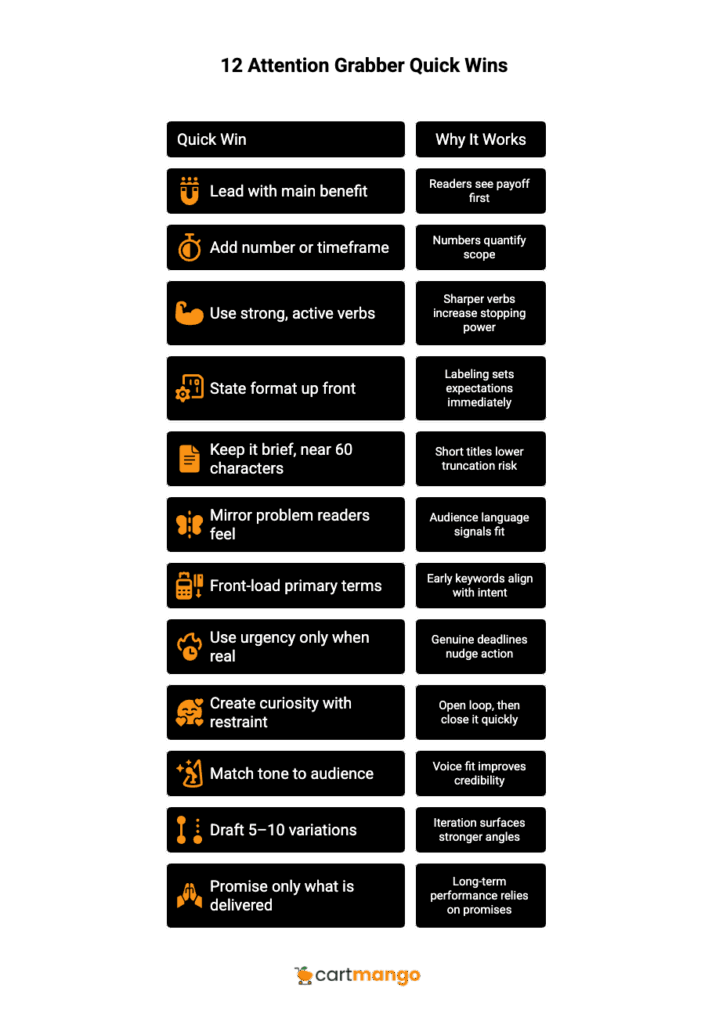
Headline formulas (with examples)
Formula | When to use | Example |
|---|---|---|
Benefit + Specific + Number | Outcome is the draw and scope matters to decision making. | 10 Proven Ways to Cut Churn in 30 Days |
Problem to Outcome | Pain to solution framing fits search and social intent. | Stop Cart Abandonment, 7 Fixes That Recover Sales Fast |
How‑to + Audience | Role‑specific cues build trust quickly and filter clicks. | How to Write Headlines CFOs Trust |
Question that promises an answer | Informational queries seeking a clear solution or tutorial. | What Is the Fastest Way to Write Headlines That Convert? |
List + Evidence | Readers want bite‑size, research‑backed steps. | 9 Research‑Backed Headline Tweaks That Lift Clicks |
Challenge framing | A testable claim pairs curiosity with specificity. | Can These 5 Words Lift Email Opens? |
More headline techniques
This section groups the core levers that move clicks while protecting trust, arranged in an order that starts with clarity, moves into specifics, applies psychology carefully, and finishes with intent and audience fit.
Clarity, relevance, brevity
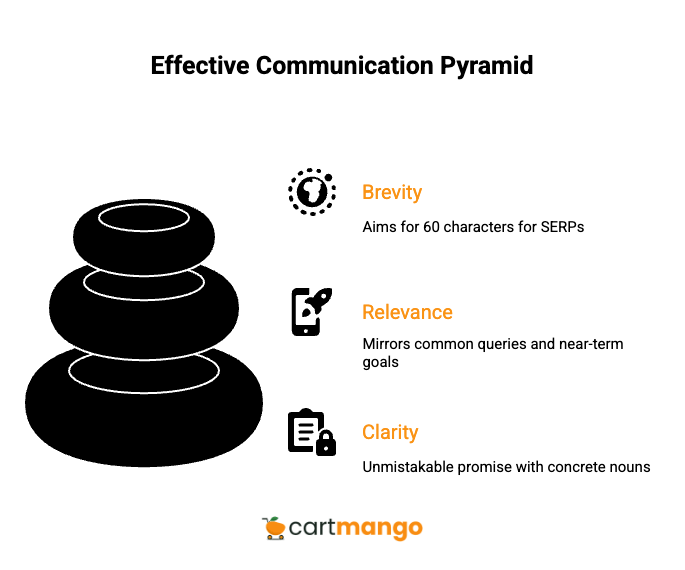
Clarity means the promise is unmistakable on first read, with concrete nouns and active verbs instead of vague labels or abstract phrasing.
Relevance rises when wording mirrors common queries and near‑term goals that matter to the segment, which can be pressure‑tested with a short checklist before publishing.
For SERPs, aiming near about 60 characters helps reduce cutoffs while keeping the core promise visible across device widths, which aligns with current analysis and guidance.
A simple 3‑question test works in seconds, asking if:
- the benefit is obvious in the first few words
- a key term is front‑loaded
- the headline still makes sense out of context
When a title must run longer for clarity, moving essential terms to the front and trimming modifiers at the end preserves meaning under display limits. Active voice and strong verbs sharpen the payoff and lower cognitive load in scan‑heavy feeds.
Numbers, specifics, benefits
Numbers increase perceived credibility by making scope visible, such as steps, days, or a tight window that feels doable.
Specifics help readers decide fast, and modest claims work better over time than big promises the content cannot support. Leading with the benefit is the key move because readers care about saved time, recovered revenue, or lower costs, not the internal feature list.
Odd numbers sometimes test well, which makes them a useful lever to try rather than a universal rule to obey blindly. Precise windows such as 14 or 30 days tend to feel more believable than open‑ended claims with no boundary. If a number is used, backing it up near the top of the content protects trust in the first screen.
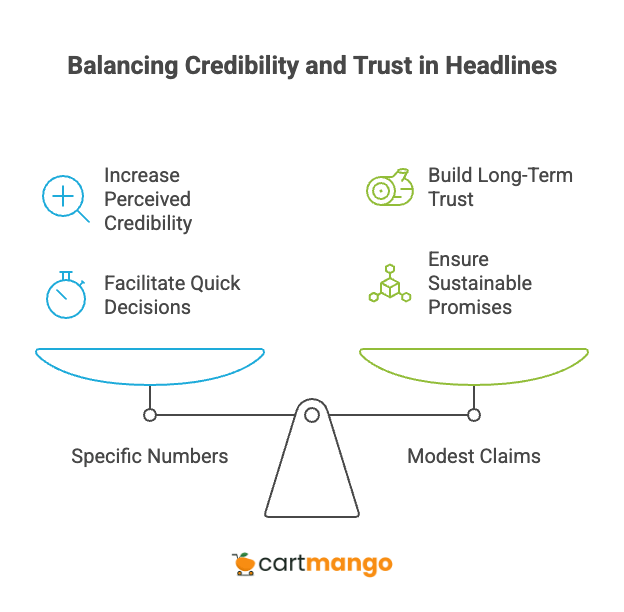
Emotion, curiosity, urgency
Emotion can lift attention when grounded in relief, surprise, or regained control, and it avoids empty intensifiers that promise more than the content can pay off.
Curiosity works best when the body closes the loop quickly, turning the open question into a useful answer without delay. Urgency belongs only when a real deadline or scarcity exists, which mirrors public communications guidance and avoids credibility loss.
Short and honest phrasing outperforms hype over time, which protects repeat engagement and makes future tests more reliable. A practical calibration step asks whether a skeptical reader would consider the wording fair based on the first few paragraphs. If not, lowering intensity and raising specificity is the safer adjustment.
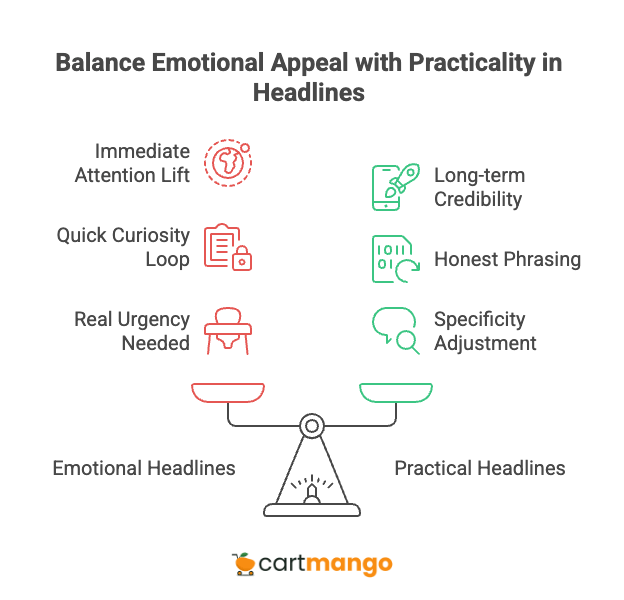
Match search intent and audience
Intent types such as informational and transactional set expectations that the headline should match from query to click for fit and satisfaction.
Role cues like founder, CFO, or HR manager can speed recognition for the right reader, which helps qualify clicks and improve engagement quality. Pain‑language mirroring works in problem to solution topics when kept accurate and free of puffery.
A tight fit between intent and headline tends to lower fast bounces and raise perceived usefulness, which supports downstream metrics. When two options both seem viable, the simpler line that clearly states the outcome usually wins more clicks and creates fewer rewrites.
For search‑friendly phrasing examples and audience fit reminders, this explainer breaks it down in plain language.
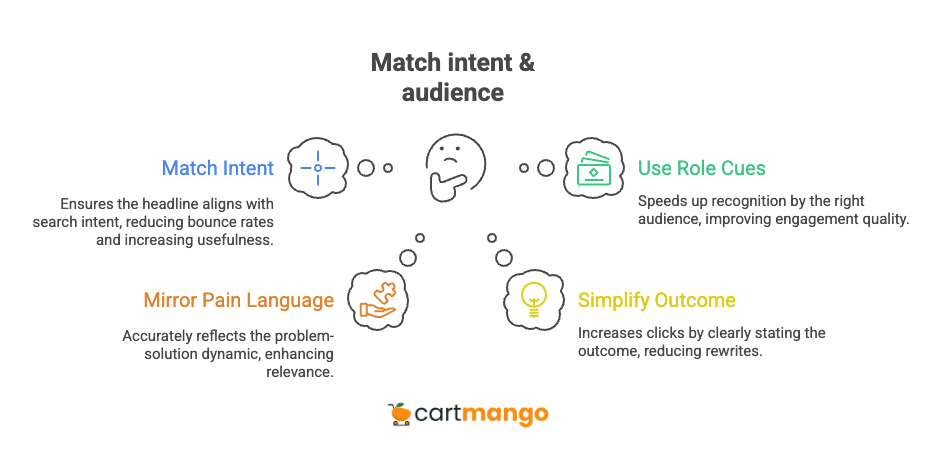
Headline templates
X Ways to [Outcome] Without [Unwanted Thing]
E.g. 7 Ways to Boost CTR Without Clickbait
(sets a clear benefit and a boundary that protects trust)
How to [Do Outcome] in [Timeframe or Constraint]
E.g. How to Write Headlines in 5 Minutes
(adds a constraint that feels doable and honest)
The [Audience] Guide to [Desired Result]
E.g. The Founder Guide to High‑Trust Headlines
(pairs a role cue with an outcome to speed relevance)
6 Steps to creating your headline

Step | What to do | Quality checks |
|---|---|---|
Define purpose and audience | Write a one‑line promise and name who it serves to anchor ideation and alignment. | Does the headline fulfill that promise for this reader segment without hedging. |
Mine benefits and proof | List outcomes, constraints, numbers, differentiators, and proof points to turn into headline angles. | Is the benefit concrete and supported near the top of the content. |
Draft 5–10 variants | Explore number, verb, benefit, and role cue to isolate high‑leverage differences. | Are variants meaningfully different, readable, and on‑brand. |
Aim for about 60 characters | Trim non‑essentials and front‑load terms to protect meaning in SERPs and feeds across devices. | Is the core promise visible without truncation in common displays. |
Pick top 2–3 and test | Match variants to channel constraints and measure with clean comparisons over time. | Do results replicate across segments instead of a one‑off spike. |
Refresh winners quarterly | Update wording to avoid fatigue while preserving the core promise that worked. | Did performance hold or rebound after refresh. |
Points worth repeating (and more)
We talked some of the points below, but they’re worth repeating.
Common headline mistakes
Even great headlines can fail when basic errors creep in, and what can you do to make a headline more compelling starts with avoiding the traps that create disappointed readers.
Clickbait headlines promise more than the content delivers, which burns trust and hurts future engagement when people expect one thing but find incomplete information instead.
The most frequent error involves unnecessary words that dilute the core promise, turning a compelling headline into something that tries to grab attention but loses focus. A good headline should speak directly to the reader’s interest without fluff, while common mistakes include chasing just clicks instead of offering real value that keeps people engaged past the first paragraph.
Small businesses often struggle with this balance, cramming too many ideas into one line when five words might work better than fifteen. The article should match what the headline promises, and every tips section should deliver on the story or idea that initially sparked the reader’s interest.
Advanced headline writing tips for optimization
Moving beyond basics, catchy headlines require the right mix of headline writing tips that combine emotional words and power words to trigger an emotional response.
A headline analyzer can help identify whether your compelling headline includes these elements effectively. Different headlines work for different audiences, so testing two headlines against each other reveals which approach helps engage readers and evoke emotions more effectively.
Specific headlines tend to outperform vague ones because they set clear expectations about what readers will gain from the content. Long tail keywords can strengthen search performance while powerful words create urgency or curiosity that makes your headline stand out in crowded feeds.
The key is matching emotional words to your brand’s voice and the specific audience you want to reach, ensuring each headline makes a clear promise that the content can fulfill.
For instance, using the right combination of relevant keywords and emotional triggers helps the headline connect with the reader’s interest while staying true to what the article actually covers.
Channel-specific headline considerations
Headlines that work in search results may need adjustment for social media feeds, where the format and context change how people scan and decide to click.
Your target audience behaves differently across channels, so a headline that performs well in email might need tweaking to engage readers on LinkedIn or Twitter / X where attention spans are shorter. Keeping your headline concise becomes crucial across all platforms.
The goal remains creating effective headlines that save money on paid promotion by earning organic reach, but this requires understanding how each platform displays and truncates titles. Special characters can help headlines stand out in some feeds but may cause display issues in others, so testing across channels reveals what actually works for your specific audience.
Remember that disappointed readers share negative experiences faster than positive ones, so every headline should set realistic expectations that the content can exceed rather than fall short of.
Whether someone finds your content through search results or social media feeds, the promise should match the payoff to build trust that supports long-term engagement and growth.
What next?
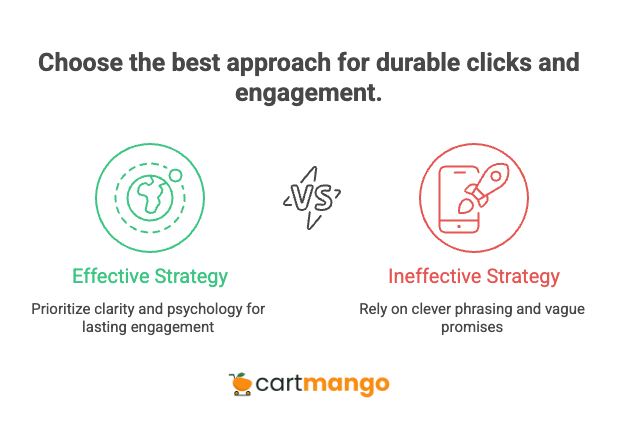
Clarity first, specifics second, and psychology in measured doses tends to win more durable clicks than clever phrasing with vague promises.
A practical target near 60 characters protects display while front‑loading the benefit and key terms, and testing 5–10 variants reveals which angle fits the channel and reader best.
Light refresh cycles keep language from going stale while preserving the promise that actually earned attention.
Related
- SendOwl vs SamCart: The Recurring Revenue Jail (2026)
- ThriveCart vs ClickFunnels: When more features hurt (2026)
- SendOwl vs Payhip: The “You-Leave-You-Lose” Model (2026)
- SamCart vs Kajabi: The Income Hostage Trap (2026)
- Sellfy vs Payhip: The Recurring Revenue Prison (2026)
- Podia vs Gumroad: The Recurring Revenue Handcuffs (2026)
- SendOwl vs Gumroad: The Recurring Revenue Black Hole (2026)
- Gumroad vs Sellfy: The Vendor Lock-in Cage (2026)
- Gumroad vs Payhip: The Hidden Trap for Creators (2026)
- ThriveCart vs SamCart – The Subscription Hostage Trap (2026)
